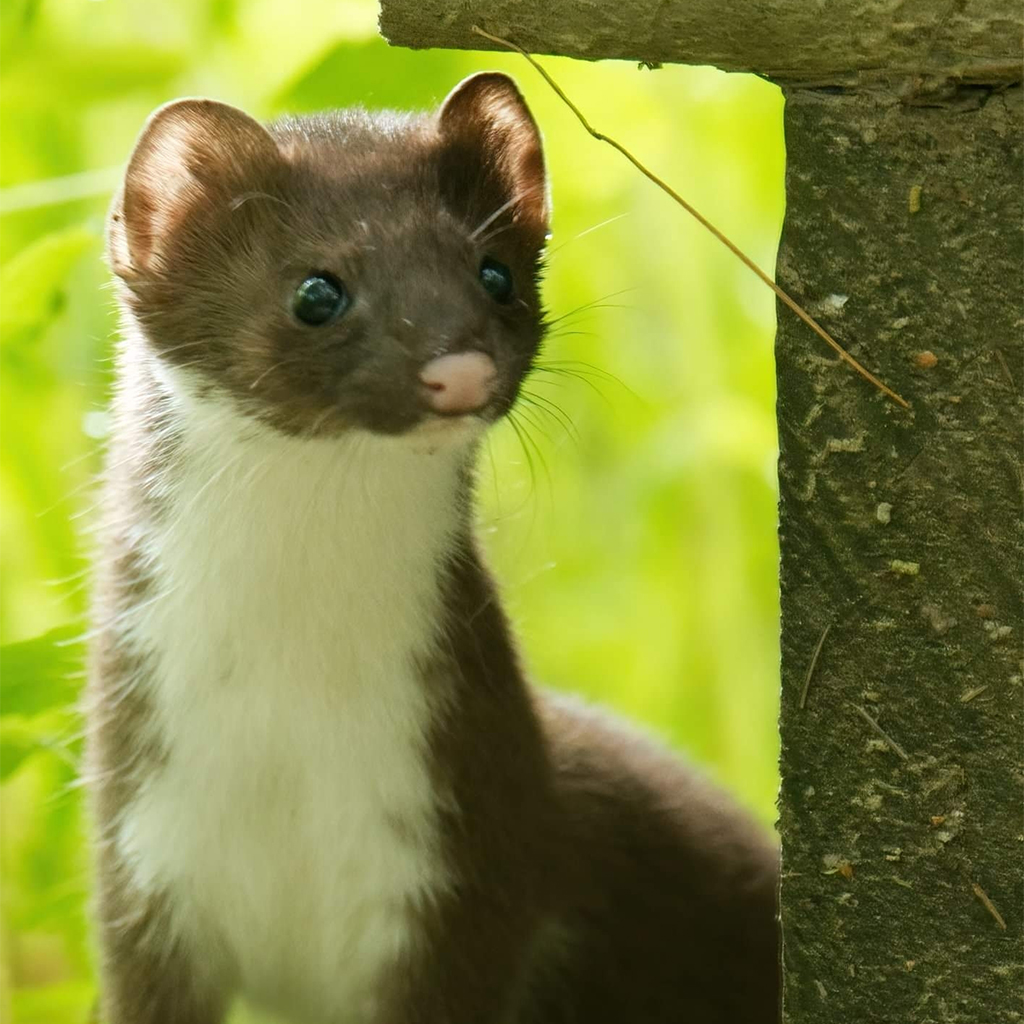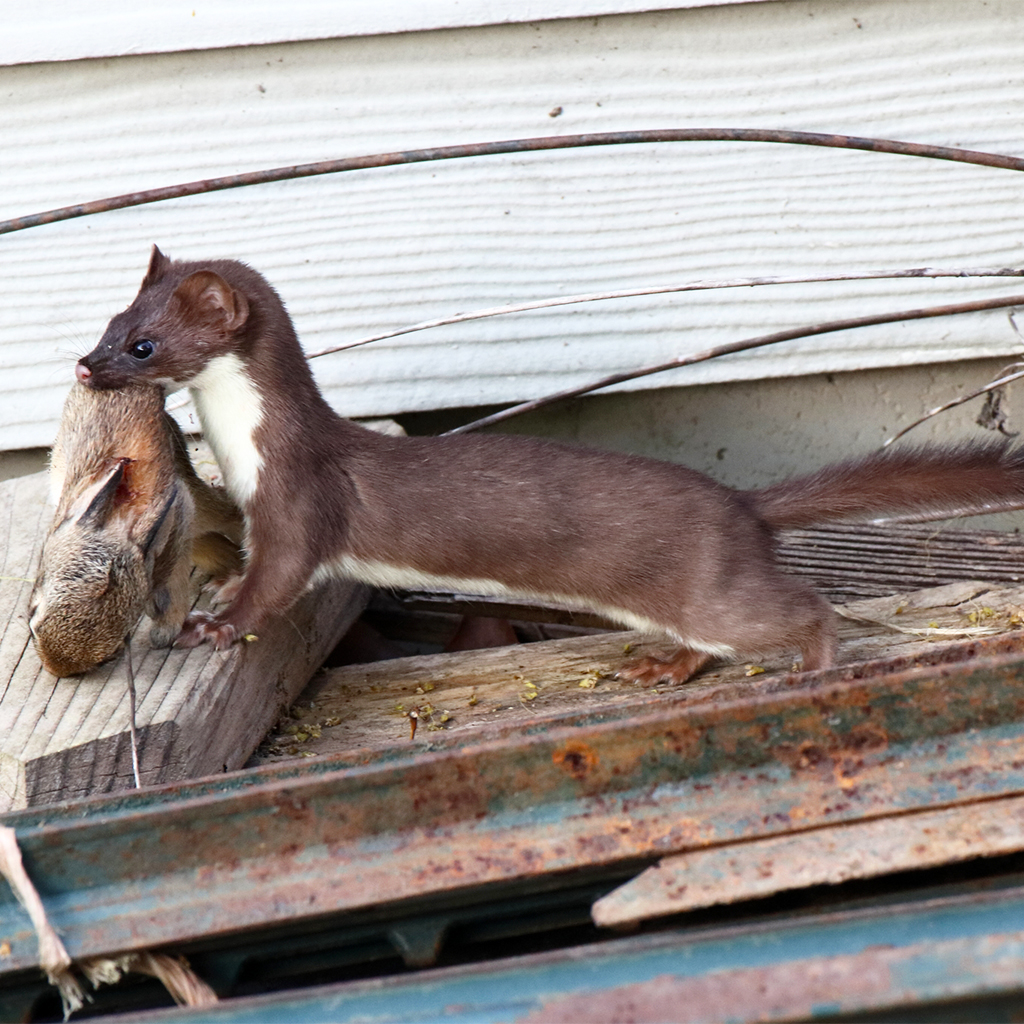Long-tailed weasels are sleek rodent hunters with lives that will surprise – even before birth

A long-tailed weasel moves its babies in Alberta, Canada, in April 2021. (Photo: John Krampl Photography)
The long-tailed weasel (Neogale frenata) is found throughout the United States and southern Canada, including right here in Cambridge. It is related to the mink, river otter, marten and fisher, but it is smaller. A long-tailed weasel is about half the weight of a gray squirrel. This weasel evolved in North America about 2 million years ago, thriving during the last ice age because its long, thin body allowed it to hunt in burrows and beneath snow. Today, its slender body and short legs make it an efficient rodent-harvesting predator.
This weasel is brown with a white chest and a black-tipped tail. Males weigh about half a pound, while females tip the scales at a quarter of a pound. The tail is 40 percent to 70 percent as long as the body. This weasel does not hibernate and is active throughout the winter. In northern Vermont, New Hampshire and Maine, the weasel turns white in winter except for its black-tipped tail. In Massachusetts, it is rare for the long-tailed weasel to turn all white – although it may turn partially white. Some remain completely brown all winter.

A long-tailed weasel in Vermont displays its white winter coat on Dec. 26. (Photo: Craig K. Hunt)
The long-tailed weasel molts in the fall and again in the spring in response to changing hours of daylight. Each molt takes about a month and begins on the belly, progressing to the back. When threatened, the long-tailed weasel discharges a strong musky scent similar to that of a skunk, but not as strong. It also uses its scent glands to mark its territory and discourage interlopers or predators.
The long-tailed weasel mates in July or August. The fertilized egg develops for 68 days, then stops, and it is not until seven or eight months later that the egg implants in the female’s uterus. Once the egg implants, development restarts for 3.5 weeks and the female gives birth to four to eight babies in April or May. The youngsters are pink and hairless with closed eyes. They weigh about 3 grams (the weight of a penny) and rely on the parents for warmth and food.

A Cambridge weasel peers down from a tree branch at Fresh Pond on Nov. 15, 2023. (Photo: D. Dentzer)
Young weasels consume up to half their body weight in food each day and grow rapidly – and that doesn’t stop in adulthood. A high metabolic rate means the adults eat from 20 percent to 70 percent of their body weight each day, depending on the season and how active they are.
By the time they are three weeks old, the weasels are furry and can crawl around and eat meat. Their eyes open at five weeks, and by six weeks they begin to follow their mother on hunting trips. By the fall, they are fully grown and leave their mother to strike out on their own. The young females mate their first summer at only three or four months of age – but remember, they do not give birth until the following spring when they are a year old. Males become sexually mature about a year later than females.

A long-tailed weasel devours its rabbit prey in Vermont on Jan. 20, 2019. (Photo: Henry Trombley)
The long-tailed weasel may modify abandoned chipmunk or rodent burrows to use as a home, lining the nest chamber with straw and fur from prey. This weasel uses one spot near the burrow as a toileting area where it leaves its long and often twisty scat.
The long-tailed weasel is a fearless (largely nighttime) hunter that will attack animals much larger than itself. When it stalks prey, it explores every hole, crevice, root system or brush pile while moving its head from side to side to pick up a scent. Weasels have an acute sense of smell and hearing, but do not see that well.

An alert weasel surveys its surroundings in Central Massachusetts on June 30, 2022. (Photo: Brian Zylich)
Because of its smaller body, the female hunts small prey such as mice or chipmunks. She bites the prey repeatedly at the base of the skull, severing or crushing the spinal cord. Males tend to hunt larger prey such as rabbits or squirrels. When hunting large prey, the weasel grabs the nearest part of the animal and climbs on its body, holding tightly with its feet. It then inflicts lethal bites to the neck or base of the skull. Weasels will go after prey in burrows, biting down on the throat to suffocate prey that cannot struggle much in cramped quarters. A weasel’s hunting success rate is correlated to the size of the prey: Weasels are more successful when they hunt smaller prey. Males travel up to 3.5 miles per night searching for prey, while females travel half a mile per night.

A weasel in Utah carries off a vole on Nov. 17, 2015. (Photo: J. Barney)
Weasels eat the fur, flesh, and bones of small prey, but only the flesh from larger prey. Long-tailed weasels prefer to eat fresh, usually mice, voles, rats, squirrels, chipmunks and rabbits. Once in a while they eat birds or their eggs, fish, snakes, worms, frogs or insects. When raising youngsters, the weasel might cache extra food near the nest.
The weasels is vulnerable to coyotes and foxes, hawks and owls. To escape danger, it may climb a tree and sits silently waiting for the predator to pass. In the snow, a white weasel may use its black-tipped tail to distract a predator from the rest of its body. When the hawk, for example, attacks the tail, the weasel makes its escape. Since weasels are speedy, aggressive and smelly, predators may leave them alone if other prey is available.

A weasel with a young rabbit in Natick on May 10. (Photo: Dylan Jacques-Fero)
Although their elusive nature and nocturnal habits make long-tailed weasels challenging to observe in the wild, they are around us, helping to keep our rodent population under control. It is up to us, therefore, to preserve natural habitats so that these creatures and others can continue to thrive.![]()
Have you taken photos of our urban wild things? Send your images to Cambridge Day, and we may use them as part of a future feature. Include the photographer’s name, date and the general location where the photo was taken as well as any other relevant information.
Jeanine Farley is an educational writer who has lived in the Boston area for more than 30 years. She enjoys taking photos of our urban wild things.


